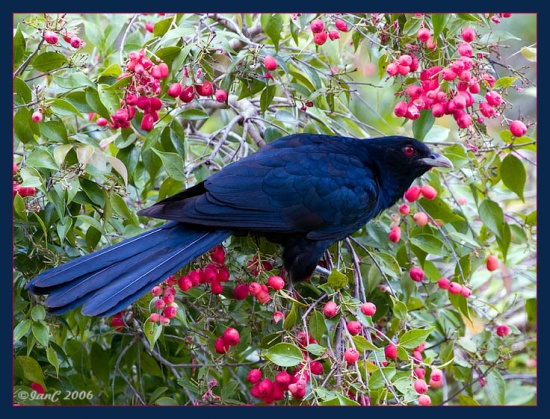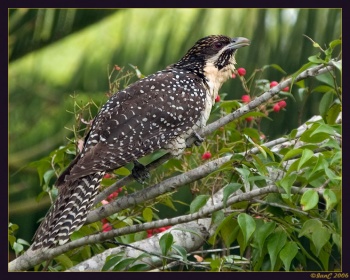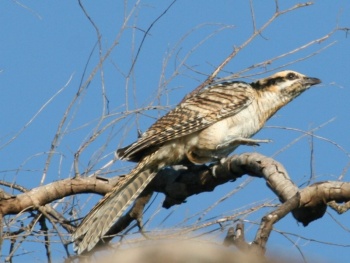(add subspecies, ref) |
m (→Vocalisation: amended layout) |
||
| (7 intermediate revisions by 3 users not shown) | |||
| Line 1: | Line 1: | ||
| − | [[Image:Australian_Koel.jpg|thumb|550px|right|Male<br />Photo by {{user|IanC|IanC}}<br />Port Macquarie, [[New South Wales]], December 2006]] | + | [[Image:Australian_Koel.jpg|thumb|550px|right|Male<br />Photo © by {{user|IanC|IanC}}<br />Port Macquarie, [[New South Wales]], December 2006]] |
| + | '''Alternative names: Eastern Koel; "Australian Koel" | ||
;[[:Category:Eudynamys|Eudynamys]] orientalis | ;[[:Category:Eudynamys|Eudynamys]] orientalis | ||
==Identification== | ==Identification== | ||
| + | [[Image:44356P1026263.jpg|thumb|350px|right|Female<br />Photo © by {{user|IanC|IanC}}<br />Port Macquarie, [[New South Wales]], [[Australia]], January 2006]] | ||
'''Male''':<br /> | '''Male''':<br /> | ||
*Glossy black plumage, tinged with blue and green | *Glossy black plumage, tinged with blue and green | ||
| Line 10: | Line 12: | ||
*Buff-cream underparts with fine black bars<br /> | *Buff-cream underparts with fine black bars<br /> | ||
'''Juvenile''': resembles the adult female, but is more buff and has a dark eye. | '''Juvenile''': resembles the adult female, but is more buff and has a dark eye. | ||
| − | |||
==Distribution== | ==Distribution== | ||
| + | [[Image:10429074052 AustralianKoel 9862bfcopy.JPG|thumb|350px|right|Juvenile<br />Photo by {{user|janha|janha}}<br />Thuringowa, [[Queensland]], [[Australia]], January 2006]] | ||
Southern [[Moluccas]], [[New Guinea]], Bismarck Archipelago, [[Solomon Islands]] and north-west [[Australia]] along the north coast and down to [[New South Wales]]. Australian Birds winter in the [[Moluccan Islands]]. | Southern [[Moluccas]], [[New Guinea]], Bismarck Archipelago, [[Solomon Islands]] and north-west [[Australia]] along the north coast and down to [[New South Wales]]. Australian Birds winter in the [[Moluccan Islands]]. | ||
==Taxonomy== | ==Taxonomy== | ||
| − | + | Often treated conspecific with one or both of [[Asian Koel]] and [[Black-billed Koel]]. | |
| − | ====Subspecies<sup>[[#References|[1]]]</sup> | + | ====Subspecies==== |
| − | + | [[File:BF Pacific Koel female flight fthsm.jpg|thumb|350px|right|Female<br />Photo © by {{user|fthsm|fthsm}}<br />Paramatta River, Sydney, [[New South Wales]], [[Australia]], November 2008]] | |
| + | Eight subspecies in two groups<sup>[[#References|[1]]]</sup>: | ||
* Oriental Koel | * Oriental Koel | ||
**''E. o. orientalis'': in southern Molucccas (Buru, Manipa, Kelang, Seram, Ambon, Watubela) | **''E. o. orientalis'': in southern Molucccas (Buru, Manipa, Kelang, Seram, Ambon, Watubela) | ||
| Line 27: | Line 30: | ||
**''E. o. subcyanocephalus'': North-western [[Australia]] to north-western [[Queensland]]; winters to southern [[Moluccas]] | **''E. o. subcyanocephalus'': North-western [[Australia]] to north-western [[Queensland]]; winters to southern [[Moluccas]] | ||
**''E. o. cyanocephalus'': Northern [[Queensland]] to southern [[New South Wales]]; winters to [[Moluccas]] | **''E. o. cyanocephalus'': Northern [[Queensland]] to southern [[New South Wales]]; winters to [[Moluccas]] | ||
| − | |||
==Habitat== | ==Habitat== | ||
| − | + | [[File:BF Pacific Koel fledgling, Red Wattlebird fthsm.jpg|thumb|350px|right|Fledgling being fed by [[Red Wattlebird]]<br />Photo © by {{user|fthsm|fthsm}}<br />Fairyland, Sydney, [[New South Wales]], [[Australia]], December 2008]] | |
| + | Can be found in mature primary and secondary forests, plantations, woodlands, gardens and on golf courses. | ||
| + | |||
==Behaviour== | ==Behaviour== | ||
====Diet==== | ====Diet==== | ||
| − | + | Adults; the diet includes fruit, particularly figs. | |
====Breeding==== | ====Breeding==== | ||
| − | It is a brood parasite, laying 1 egg. | + | It is a brood parasite, laying 1 egg. Australian birds use mainly [[Noisy Friarbird]]s, or [[Red Wattlebird]]s to host their offspring. The young bird does not attempt to replace chicks in the host species nest. |
| + | ====Vocalisation==== | ||
| + | Duetting may suggest short term pair bonds forming, as well as the normal polygynous mating behaviour.<br /> | ||
| + | {{Audio|BF-Pacific-Koel-1-December-2023-ABM.mp3}}<br /> | ||
| + | Probable territorial call<br /> | ||
| + | Recording by {{user|AmateurBirdMan|AmateurBirdMan}}<br /> | ||
| + | [[Victoria]], [[Australia]], 1 December 2023 | ||
| + | |||
==In Culture== | ==In Culture== | ||
It is also colloquially known as the Rainbird or Stormbird in eastern [[Australia]], as its call is supposed to foreshadow rain. | It is also colloquially known as the Rainbird or Stormbird in eastern [[Australia]], as its call is supposed to foreshadow rain. | ||
==References== | ==References== | ||
| − | #{{Ref- | + | #{{Ref-Clements6thOct23}} |
| + | #Birds in Backyards, https://www.birdsinbackyards.net/ | ||
| + | #https://animalia.bio/pacific-koel | ||
#BirdForum Member observations | #BirdForum Member observations | ||
{{ref}} | {{ref}} | ||
| + | |||
==External Links== | ==External Links== | ||
| − | {{GSearch|Eudynamys | + | {{GSearch|"Eudynamys orientalis" {{!}} "Pacific Koel" {{!}} "Eastern Koel" {{!}} "Australian Koel"}} |
| + | <br /> | ||
| + | {{VSearch|"Eudynamys orientalis" {{!}} "Pacific Koel" {{!}} "Eastern Koel" {{!}} "Australian Koel"}} | ||
| + | {{GS-checked}}1 | ||
| + | <br /> | ||
| + | <br /> | ||
| + | |||
[[Category:Birds]] [[Category:Eudynamys]] | [[Category:Birds]] [[Category:Eudynamys]] | ||
Latest revision as of 13:27, 2 December 2023
Alternative names: Eastern Koel; "Australian Koel"
- Eudynamys orientalis
Identification
Male:
- Glossy black plumage, tinged with blue and green
- Red eye
Female:
- Glossy brown upperparts, heavily spotted with white
- Black crown
- Buff-cream underparts with fine black bars
Juvenile: resembles the adult female, but is more buff and has a dark eye.
Distribution
Southern Moluccas, New Guinea, Bismarck Archipelago, Solomon Islands and north-west Australia along the north coast and down to New South Wales. Australian Birds winter in the Moluccan Islands.
Taxonomy
Often treated conspecific with one or both of Asian Koel and Black-billed Koel.
Subspecies
Eight subspecies in two groups[1]:
- Oriental Koel
- E. o. orientalis: in southern Molucccas (Buru, Manipa, Kelang, Seram, Ambon, Watubela)
- E. o. picatus: on Kai Islands, Sumba to Timor and Roma
- E. o. rufiventer: on New Guinea
- E. o. hybrida: Long Islands (Crown, Long, and Tolokiwa), between New Guinea and New Britain
- E. o. salvadorii: on the Bismarck Archipelago
- E. o. alberti: on the Solomon Islands
- Australian Koel
- E. o. subcyanocephalus: North-western Australia to north-western Queensland; winters to southern Moluccas
- E. o. cyanocephalus: Northern Queensland to southern New South Wales; winters to Moluccas
Habitat

Photo © by fthsm
Fairyland, Sydney, New South Wales, Australia, December 2008
Can be found in mature primary and secondary forests, plantations, woodlands, gardens and on golf courses.
Behaviour
Diet
Adults; the diet includes fruit, particularly figs.
Breeding
It is a brood parasite, laying 1 egg. Australian birds use mainly Noisy Friarbirds, or Red Wattlebirds to host their offspring. The young bird does not attempt to replace chicks in the host species nest.
Vocalisation
Duetting may suggest short term pair bonds forming, as well as the normal polygynous mating behaviour.
Probable territorial call
Recording by AmateurBirdMan
Victoria, Australia, 1 December 2023
In Culture
It is also colloquially known as the Rainbird or Stormbird in eastern Australia, as its call is supposed to foreshadow rain.
References
- Clements, J. F., P. C. Rasmussen, T. S. Schulenberg, M. J. Iliff, T. A. Fredericks, J. A. Gerbracht, D. Lepage, A. Spencer, S. M. Billerman, B. L. Sullivan, and C. L. Wood. 2023. The eBird/Clements checklist of Birds of the World: v2023. Downloaded from https://www.birds.cornell.edu/clementschecklist/download/
- Birds in Backyards, https://www.birdsinbackyards.net/
- https://animalia.bio/pacific-koel
- BirdForum Member observations
Recommended Citation
- BirdForum Opus contributors. (2024) Pacific Koel. In: BirdForum, the forum for wild birds and birding. Retrieved 28 April 2024 from https://www.birdforum.net/opus/Pacific_Koel
External Links
GSearch checked for 2020 platform.1







